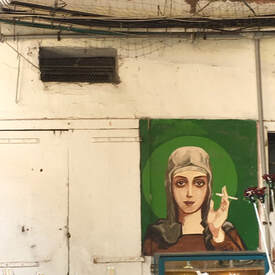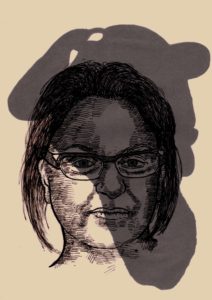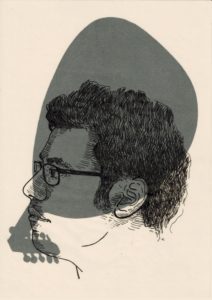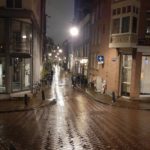Sophie Levy ~ Fiction, Poetry, And The Shaping Of Mizrahi Cultural Consciousness
“So sometimes people think we are Arabs
and they are Jews?
[My nephew’s] words make flocks of birds fly through my body
ripping my blood vessels in the commotion
and I want to tell him about my Grandmother Sham’a
and Uncle Moussa and Uncle Daoud and Uncle Awad
But at the age of six he already has
Grandmother Ziona
Grandmother Yaffa
lots of uncles
and fear and war
he received as a gift
from the state.”
– Adi Keissar, “Clock Square”
I read Adi Keissar’s poetry for the first time at fifteen years old, when my mother forwarded me a link to Haaretz’s Poem of the Week under the headline “Who’s who? Who’s an Arab, who’s a Jew?”
The poem was a vignette of a conversation between Keissar and her young nephew as they walked beside the clock tower in Jaffa, tracing the aftermath of his distant observation of a man speaking Arabic. With each consecutive line, I felt like an anvil had been dropped on my chest (in the best way possible). Why did a Persian girl from Los Angeles who hadn’t really thought about her Judaism in years feel such a punch in the gut from a poem by a Yemeni woman in Israel? It felt incomplete and a little tacky to exclusively attribute my reaction to our shared Judaism. There was another layer to consider— a quiet but strong common denominator between the way I thought of my family and the way Keissar wrote about hers, even though I grew up hearing Farsi spoken more than Arabic, and I am American, not Israeli.
I only heard the word Mizrahi used to describe people from Middle-Eastern and North African Jewish backgrounds a few weeks before I read “Clock Square.” It made sense to me that there was another word for us out there—for Jewish people who called ourselves Sephardi even though our supposedly Spanish lineage seemed less-than-factual. It felt good to become aware of this new, audibly articulated way of making a distinction I wanted made—not because I resented the Sephardi label, but because I noticed something different about the community from which I came, and those differences were bound to Iran, not Spain. I let the word roll around inside my head and off my tongue. Mizrahi. So that’s what I’m called.
The complete article The Current – Fall 2019: http://www.columbia-current.org/fiction-poetry-and-the-shaping-of-mizrahi-cultural-consciousness.html
Mark R. Cohen ~ Historical Memory And History in The Memoirs Of Iraqi Jews
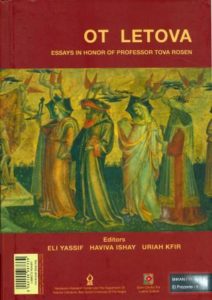 Memoirs, History, and Historical Memory
Memoirs, History, and Historical Memory
Following their departure en masse from their homeland in the middle years of the twentieth century, Jews from Iraq produced a small library of memoirs, in English, French, Hebrew, and Arabic. These works reveal much about the place of Arab Jews in that Muslim society, their role in public life, their relations with Muslims, their involvement in Arab culture, the crises that led to their departure from a country in which they had lived for centuries, and, finally, their life in the lands of their dispersion. The memoirs are complemented by some documentary films. The written sources have aroused the interest of historians and scholars of literature, though not much attention has been paid to them as artifacts of historical memory. That is the subject of the present essay.
Jews in the Islamic World before the Twentieth Century
Most would agree, despite vociferous demurrer in certain “neo-lachrymose” circles, that, especially compared to the bleaker history of Jews living in Christian lands, Jews lived fairly securely during the early, or classical, Islamic period, up to around the twelfth or thirteenth centuries. It was not, however, an interfaith utopia, because the Jews (along with Christians) were subject to legal disabilities. But they were also protected as dhimmīs, enjoying freedom of religion and movement and benefiting from untrammeled economic opportunity. These were, furthermore, centuries in which Arabic ideas penetrated deeply into the fabric of Judaism, and in which Jews shared substantially in Arabic-Islamic culture. Persecutions were few and far between and almost always directed at non-Muslims as a category, not at Jews per se. They typically occurred when non-Muslims were perceived to have violated the restrictive ordinances of the Pact of ‘Umar, ignoring the inferior status assigned to them by Islamic religion and law. Anti-Semitism, understood as an irrational belief in a malevolent, violent, anti-social Jewish alliance with satanic forces seeking to control the world, did not exist.
Most would also concur that Jews were more severely oppressed in later Islamic centuries, though the level of oppression is often generalized in the literature to the point of exaggeration. It differed in intensity and in form from place to place and circumstance to circumstance and had much to do with general decline in the Muslim world in the post-classical period, a setback that naturally affected the minorities to a greater extent than the Muslim majority. There was, moreover, a period of substantial remission and revival during the heyday of Ottoman imperial expansion in the Middle East and North Africa in the sixteenth century, which coincided with the influx of highly educated and skilled Sephardic Jews expelled from Catholic Spain in 1492. Furthermore, the modern period saw significant amelioration for at least the more well-to-do Jews in many Islamic countries.
The complete essay: https://library.osu.edu/projects/hebrew-lexicon.pdf
Previously published in: Mark R. Cohen, History and Historical Memory in the Memoirs of Iraqi Jews, in Eli Yassif, et al., eds., Ot LeTova: Essays in Honor of Professor Tova Rosen (Beer Sheva: Dvir, 2012), 110-137 (Hebrew)
The Last Days Of Jews In Iraq Before Immigration To Israel
DAILY DOSE | Jews suffered heavy persecution in Iraq, especially during the establishment of the State of Israel and before — during the peak of Nazi rule in Germany. They were left one choice: to go to Israel. But they didn’t leave their traditions behind. Our Daniel Campos has the story.
Yoav Peled ~ Towards A Redefinition Of Jewish Nationalism In Israel
 The electoral success of Shas, a mizrahi, religious political party in Israel is analysed with the help of the cultural division of labor model. Mizrahim (Jews originating in Moslem countries) are a semi-peripheral ethnic group in Israel, located between the dominant ashkenazim (Jews of European origin) and the Palestinians. While most mizrahim have been voting Likud in the past twenty-five years, increasingly the poorer among them have been shifting their vote to Shas. The key to Shas’s success, where other efforts to organize mizrahi political parties have failed, is its integrative, rather than separatist, ideology. Shas seeks to replace secular Zionism with religious Judaism as the hegemonic ideology in Israeli society, and presents this as the remedy for both the socioeconomic and the cultural grievances of its constituency. This integrative message, emphasizing the commonalities between mizrahim and ashkenazim, rather than their differences, is attractive to mizrahim because of their semi-peripheral position in the society.
The electoral success of Shas, a mizrahi, religious political party in Israel is analysed with the help of the cultural division of labor model. Mizrahim (Jews originating in Moslem countries) are a semi-peripheral ethnic group in Israel, located between the dominant ashkenazim (Jews of European origin) and the Palestinians. While most mizrahim have been voting Likud in the past twenty-five years, increasingly the poorer among them have been shifting their vote to Shas. The key to Shas’s success, where other efforts to organize mizrahi political parties have failed, is its integrative, rather than separatist, ideology. Shas seeks to replace secular Zionism with religious Judaism as the hegemonic ideology in Israeli society, and presents this as the remedy for both the socioeconomic and the cultural grievances of its constituency. This integrative message, emphasizing the commonalities between mizrahim and ashkenazim, rather than their differences, is attractive to mizrahim because of their semi-peripheral position in the society.
The complete paper (PDF): https://www.academia.edu/Towards_a_Redefinition
Ella Shohat ~ Rupture And Return. A Mizrahi Perspective On The Zionist Discourse
Eurocentric norms of scholarship have had dire consequences for the representation of Palestinian and Mizrahi history, culture and identity. In this paper I would like to examine some of the foundational premises and substratal axioms of hegemonic discourse about Middle Eastern Jews (known in the last decade as “Mizrahim”). Writing a critical Mizrahi historiography in the wake of colonialism and nationalism, both Arab and Jewish, requires the dismantling of a number of master-narratives. I will attempt to disentangle the complexities of the Mizrahi question by unsettling the conceptual borders erected by more than a century of Zionist discourse, with its fatal binarisms of savagery versus civilization, tradition versus modernity, East versus West and Arab versus Jew. This paper forms part of a larger project in which I attempt to chart a beginning for a Mizrahi epistemology through examining the terminological paradigms, the conceptual aporias and the methodological inconsistencies plaguing diverse fields of scholarship concerning Arab Jews/Mizrahim.
Central to Zionist thinking is the concept of “Kibbutz Galuiot“– the “ingathering of the exiles.” Following two millennia of homelessness and living presumably “outside of history,” Jews can once again “enter history” as subjects, as “normal” actors on the world stage by returning to their ancient birth place, Eretz Israel. In this way, Jews can heal a deformative rupture produced by exilic existence. This transformation of “Migola le’Geula” – from Diaspora to redemption – offered a teleological reading of Jewish History (with a capital H) in which Zionism formed a redemptive vehicle for the renewal of Jewish life on a demarcated terrain, no longer simply spiritual and textual, but rather national and political. Concomitant with the notion of Jewish “return” and continuity was the idea of rupture and discontinuity. In order to be transformed into New Jews, (later Israelis) the Diaspora Jews had to abandon their Diaspora – galuti – culture, which in the case of Arab- Jews meant abandoning Arabness and acquiescing in assimilationist modernization, for “their own good,” of course. Within this Promethean rescue narrative the concepts of “ingathering” and “modernization” naturalized and glossed over the epistemological violence generated by the Zionist vision of the New Jew. This rescue narrative also elided Zionism’s own role in provoking ruptures, dislocations and fragmentation, not only for Palestinian lives but also – in a different way – for Middle Eastern/North African Jews. These ruptures were not only physical (the movement across borders) but also cultural (a rift in relation to previous cultural affiliations) as well as conceptual (in the very ways time and space were conceived). Here I will critically explore the dialectics of rupture and return in Zionist discourse as it was formulated in relation to Jews from the Middle East/North Africa. I will examine these dialectics through the following grids: a) dislocation: space and the question of naming; b) dismemberment: the erasure of the hyphen in the “Judeo-Muslim;” c) dis-chronicity: temporality and the project of modernization; d) dissonance: methodological and discursive ruptures.
The complete paper: https://www.juragentium.org/topics/palestin/doc07/en/shohat.htm
Published in Jura Gentium, Rivista di filosofia del diritto internazionale e della politica globale, ISSN 1826-8269
Translating The Arab-Jewish Tradition: From Al-Andalus To Palestine/Land Of Israel
This essay investigates the vision of two Jewish scholars of a shared Arab-Jewish history at the beginning of the twentieth century.
The first part of the essay focuses on Abraham Shalom Yahuda’s re-examination of the Andalusian legacy in regard of the process of Jewish modernisation with respect to the symbolic and the actual return to the East. The second part of the essay centers on the work of Yosef Meyouhas (1863-1942), Yahuda’s contemporary and life-long friend who translated a collection of Biblical stories from the Arab-Palestinian oral tradition, examining the significance of this work vis-à-vis the mainstream Zionist approach.[1]
A Dispute in Early Twentieth-Century Jerusalem
On a winter’s evening late in 1920, in an auditorium close to Jerusalem’s Damascus Gate (“bab al-‘amud”), Professor Abraham Shalom Yahuda (1877-1951) gave a lecture attended by an audience of Muslim, Christian and Jewish Palestinian intellectuals and public figures.[2] Its subject matter was the glory days of Arabic culture in al-Andalus.
The event was organized and hosted by the Jerusalem City Council in honour of the newly appointed British High Commissioner Herbert Samuel (1870-1963). In his opening address, Mayor Raghib al-Nashashibi (1881-1951) introduced the speaker as a Jerusalemite, son of one of the most respected Jewish families in the city.[3]
In his lecture, delivered in literary Arabic, Abraham Shalom Yahuda, since 1914 Professor of Jewish History and Literature and Arabic Culture at the University of Madrid portrayed the golden era of Muslim Spain describing the great accomplishments of Muslims and Jews during this period in the fields of science, literature, philosophy, medicine and art and emphasizing the fruitful relations between them. This event was an important moment in the life of this scholar of Semitic culture, one in which his long-standing scientific and political projects merged.
From his early days in Jerusalem, and later on in Germany as a student in Heidelberg and as a lecturer at the Berlin “Hochschule für die Wissenschaft des Judentums” (1904-1914), Yahuda had focused on the Andalusian legacy, emphasising the historical and philological aspects of the Judeo-Muslim symbiosis during that period and its symbolic significance for the modernization and revitalization of Jewish and Hebrew culture. This issue was at the heart of Yahuda’s long-standing debate with Jewish scholars regarding the different options for Jewish modernization. Towards the end of his lecture, Yahuda addressed the Arab Palestinians in the audience directly. Speaking from the heart, albeit in a slightly pompous tone, he called on them to revive the legacy of al-Andalus:
If the opportunity exists today for the Arabs to return to their ancient Enlightenment, it has been made possible only by virtue of the empires that fought for the rights of suppressed peoples.
If the Arabs revive their glorious past through the good will of these empires, especially that of Great Britain, which is willing to help them as much as possible, they have to return to their essence of generosity and allow the other suppressed peoples, including the People of Israel, to benefit from the national rights granted by the British Government. Only when the spirit of tolerance and freedom that prevailed in the golden age of Arab thought in al-Andalus […] will return to prevail today, in a way that will enable all peoples, without religious or ethnic prejudice, to work together for the revival of enlightenment in the Eastern nations, each people according to its unique character and traditions, can an all-encompassing Eastern enlightenment be reborn that will include all Eastern nations and peoples.[4]
Thus, Yahuda chose to end his lecture with a political statement regarding the future of Palestine in this new imperial era. Well aware of the importance of his words in such dramatic times, Yahuda proposed a symbolic return to al-Andalus as a potential political and cultural platform for Jews and Arabs in post-Ottoman Palestine. While it is hard not to see an affinity with the British Empire in his words, we should however note the unique context in which this lecture took place: a few months after the official beginning of British Mandatory rule in Palestine, at an occasion dedicated to the newly appointed High Commissioner Herbert Samuel and in his presence.[5]
However, the event also had a more specific historical context, as it took place on the same night that the third Arab National Congress opened in Haifa. The lecture was organized by Raghib al-Nashashibi in honour of Herbert Samuel, and Nashashibi invited Yahuda to give the main lecture. As the historian Safa Khulusi has suggested, this clash was probably not coincidental, but rather was part of the internal political struggle within the Arab Palestinian community.[6]
During the end of the Ottoman period, and more intensively throughout the British Mandate, the Palestinian political leadership was deeply divided between a few notable families.
The rivalry between the two leading Jerusalemite families—the Nashashibis and the Husseinis—split the local leadership into two main camps: the national camp, under Haj Amin al-Husseini, and the opposition camp, led by Raghib al-Nashashibi. Both families drew supporters from other elite families and refused to cooperate with each other, resulting in a deep political divide in Palestinian society.[7]
This split, which dominated the Palestinian political arena throughout the Mandatory period, had its origins in the early days of British rule, when Raghib al-Nashashibi was appointed Mayor of Jerusalem after the British Military Commissioner removed Musa Kazim al-Husseini (1853-1934) from office.[8]
The three-day Arab congress in Haifa was organized by members of the al-Husseini family and led by Kazim al-Husseini.
Just a few months after the French army destroyed the short-lived constitutional Arab Kingdom of Syria under King Faysal (1885-1933), and amid the ruins of the first modern Arab state in Bilad al-Sham (Greater Syria) that projected equal citizenship to all, the participants in the Haifa congress sought to establish a new strategy towards British rule and towards the Balfour Declaration and the notion of a homeland for the Jewish people.
